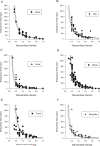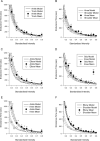Endurance time is joint-specific: a modelling and meta-analysis investigation
- PMID: 20069487
- PMCID: PMC2891087
- DOI: 10.1080/00140130903389068
Endurance time is joint-specific: a modelling and meta-analysis investigation
Abstract
Static task intensity-endurance time (ET) relationships (e.g. Rohmert's curve) were first reported decades ago. However, a comprehensive meta-analysis to compare experimentally-observed ETs across bodily regions has not been reported. We performed a systematic literature review of ETs for static contractions, developed joint-specific power and exponential models of the intensity-ET relationships, and compared these models between each joint (ankle, trunk, hand/grip, elbow, knee, and shoulder) and the pooled data (generalised curve). 194 publications were found, representing a total of 369 data points. The power model provided the best fit to the experimental data. Significant intensity-dependent ET differences were predicted between each pair of joints. Overall, the ankle was most fatigue-resistant, followed by the trunk, hand/grip, elbow, knee and finally the shoulder was most fatigable. We conclude ET varies systematically between joints, in some cases with large effect sizes. Thus, a single generalised ET model does not adequately represent fatigue across joints. STATEMENT OF RELEVANCE: Rohmert curves have been used in ergonomic analyses of fatigue, as there are limited tools available to accurately predict force decrements. This study provides updated endurance time-intensity curves using a large meta-analysis of fatigue data. Specific models derived for five distinct joint regions should further increase prediction accuracy.
Figures





Similar articles
-
Systemic pharmacological treatments for chronic plaque psoriasis: a network meta-analysis.Cochrane Database Syst Rev. 2021 Apr 19;4(4):CD011535. doi: 10.1002/14651858.CD011535.pub4. Cochrane Database Syst Rev. 2021. Update in: Cochrane Database Syst Rev. 2022 May 23;5:CD011535. doi: 10.1002/14651858.CD011535.pub5. PMID: 33871055 Free PMC article. Updated.
-
Drugs for preventing postoperative nausea and vomiting in adults after general anaesthesia: a network meta-analysis.Cochrane Database Syst Rev. 2020 Oct 19;10(10):CD012859. doi: 10.1002/14651858.CD012859.pub2. Cochrane Database Syst Rev. 2020. PMID: 33075160 Free PMC article.
-
Physical exercise training interventions for children and young adults during and after treatment for childhood cancer.Cochrane Database Syst Rev. 2016 Mar 31;3(3):CD008796. doi: 10.1002/14651858.CD008796.pub3. Cochrane Database Syst Rev. 2016. PMID: 27030386 Free PMC article.
-
Systemic pharmacological treatments for chronic plaque psoriasis: a network meta-analysis.Cochrane Database Syst Rev. 2017 Dec 22;12(12):CD011535. doi: 10.1002/14651858.CD011535.pub2. Cochrane Database Syst Rev. 2017. Update in: Cochrane Database Syst Rev. 2020 Jan 9;1:CD011535. doi: 10.1002/14651858.CD011535.pub3. PMID: 29271481 Free PMC article. Updated.
-
Antidepressants for pain management in adults with chronic pain: a network meta-analysis.Health Technol Assess. 2024 Oct;28(62):1-155. doi: 10.3310/MKRT2948. Health Technol Assess. 2024. PMID: 39367772 Free PMC article.
Cited by
-
Variation of force amplitude and its effects on local fatigue.Eur J Appl Physiol. 2012 Nov;112(11):3865-79. doi: 10.1007/s00421-012-2375-z. Epub 2012 Mar 10. Eur J Appl Physiol. 2012. PMID: 22407330
-
Forearm elevation impairs local static handgrip endurance likely through reduction in vascular conductance and perfusion pressure: revisiting Rohmert's curve.Sci Rep. 2025 Jan 8;15(1):1250. doi: 10.1038/s41598-024-83939-7. Sci Rep. 2025. PMID: 39774653 Free PMC article.
-
A Non-Weight Bearing Method for Measuring Hip Abduction Strength Overestimates Hip Abductor Muscle Fatigue During One-Leg Stance.IISE Trans Occup Ergon Hum Factors. 2024 Oct 3:1-9. doi: 10.1080/24725838.2024.2409261. Online ahead of print. IISE Trans Occup Ergon Hum Factors. 2024. PMID: 39360398
-
A knowledge-based equation of daily work exposure.PLoS One. 2025 Jun 10;20(6):e0324924. doi: 10.1371/journal.pone.0324924. eCollection 2025. PLoS One. 2025. PMID: 40493537 Free PMC article.
-
Strength Decrease, Perceived Physical Exertion and Endurance Time for Backpacking Tasks.Int J Environ Res Public Health. 2019 Apr 11;16(7):1296. doi: 10.3390/ijerph16071296. Int J Environ Res Public Health. 2019. PMID: 30978951 Free PMC article.
References
-
- Agre JC, Rodriquez AA. Neuromuscular function: Comparison of symptomatic and asymptomatic polio subjects to control subjects. Archives of Physical Medicine and Rehabilitation. 1990;71(8):545–551. - PubMed
-
- Alizadehkhaiyat O, et al. Strength and fatigability of selected muscles in upper limb: Assessing muscle imbalance relevant to tennis elbow. Journal of Electromyography and Kinesiology. 2007;17(4):428–436. - PubMed
-
- Alway SE. Is fiber mitochondrial volume density a good indicator of muscle fatigability to isometric exercise? Journal of Applied Physiology. 1991;70(5):2111–2119. - PubMed
-
- Bazzucchi I, et al. Differences in the force/endurance relationship between young and older men. European Journal of Applied Physiology. 2005;93(4):390–397. - PubMed
Publication types
MeSH terms
Grants and funding
LinkOut - more resources
Full Text Sources
Research Materials
